Contamination Level in Geo-Accumulation Index of River Sediments at Artisanal and Small-Scale Gold Mining Area in Gorontalo Province, Indonesia
Abstract
1. Introduction
2. Materials and Methods
2.1. Research Areas
2.2. Samples
2.3. Analytical Methods
3. Results
3.1. Concentration of Hg in River Sediments at ASGM Area and Control Area
3.2. Concentration of Pb in River Sediments at ASGM Area and Control Area
3.3. Concentrations of As in River Sediments at ASGM Area and Control Area
3.4. Concentration of Zn in River Sediments at ASGM Area and Control Area
3.5. Igeo in Heavy Metal Concentration
| Igeo Value | Class | Quality of Sediment |
|---|---|---|
| ≤0 | 0 | Unpolluted |
| 0–1 | 1 | From unpolluted to moderately polluted |
| 1–2 | 2 | Moderately polluted |
| 2–3 | 3 | From moderately to strongly polluted |
| 3–4 | 4 | Strongly polluted |
| 4–5 | 5 | From strongly to extremely polluted |
| >5 | 6 | Extremely polluted |
3.6. Correlation Data of Each Element
4. Discussion
4.1. Sources of Heavy Metals in the River Sediment of Gorontalo Province
4.2. The Effect of Heavy Metal Pollution on Sediments
4.3. Impact of ASGM on/for River Sediment
4.4. Heavy Metal Interaction (Hg, Pb, and As) Release in the Environment from Source of ASGM Site to River Sediment in this Study Area
5. Conclusions
Author Contributions
Funding
Institutional Review Board Statement
Informed Consent Statement
Data Availability Statement
Acknowledgments
Conflicts of Interest
References
- Miserendino, R.A.; Bergquist, B.A.; Adler, S.E.; Guimarães, J.R.D.; Lees, P.S.J.; Niquen, W.; Veiga, M.M. Challenges to measuring, monitoring, and addressing the cumulative impacts of artisanal and small-scale gold mining in Ecuador. Resour. Policy 2013, 38, 713–722. [Google Scholar] [CrossRef]
- United Nations Environmental Protection/Global Program of Action. Why The Marine Environment Needs Protection from Heavy Metals; United Nations Environmental Protection/Global Program of Action: Nairobi, Kenya, 2004. [Google Scholar]
- Unido & University. A UNEP Global Mercury Partnership Document Produced in Conjunction with the Artisanal Gold Council and with Assistance; Commission on Geoscience for Environmental Management: Vienna, Austria; Iugs-Gem: Wina, Austria, 2012. [Google Scholar]
- Peplow, D. Environmental Impacts of Mining in Eastern Washington. In Center for Water and Watershed Studies Fact Sheet; University of Washington: Seattle, DC, USA, 1999. [Google Scholar]
- Lenntech, K. Water Treatment and Air Purification; Lenntech: Rotterdamseweg, The Netherlands, 2004. [Google Scholar]
- Habashi, F. Environmental Issues in the Metallurgical Industry–Progress and Problems. In Environmental Issues and Waste Management in Energy and Mineral Production; Balkama: Rotherdam, The Netherlands, 1992; Volume 2, pp. 1143–1153. [Google Scholar]
- Graham Sustainable Institute. An Integrated Assessment of Artisanal and Small-Scale Gold Mining in Ghana: Final Report. Ghana Mich. Gold Min. Integr. Assess. 2015, 12, 5143–5176. [Google Scholar]
- Aspinall, C. Small-scale mining in Indonesia. Min. Miner. Sustain. Dev. 2001, 79, 30. Available online: http://pubs.iied.org/pdfs/G00725.pdf (accessed on 24 May 2020).
- Puluhulawa, F.; Harun, A.A. Policy formalization of Artisanal and Small-Scale Gold Mining (ASGM) post-ratification of Minamata Convention for Sustainability (case study of ASGM Gorontalo). E3S Web Conf. 2019, 125, 2006. [Google Scholar] [CrossRef]
- Krisnayanti, B.D. ASGM status in West Nusa Tenggara Province, Indonesia. J. Degrad. Min. Lands Manag. 2018, 5, 1077–1084. [Google Scholar] [CrossRef]
- Bruno, D.E.; Ruban, D.A.; Tiess, G.; Pirrone, N.; Perrotta, P.; Mikhailenko, A.V.; Yashalova, N.N. Artisanal and small-scale gold mining, meandering tropical rivers, and geological heritage: Evidence from Brazil and Indonesia. Sci. Total Environ. 2020, 715, 136907. [Google Scholar] [CrossRef] [PubMed]
- Mahmud, M. Model Sebaran Spasial Temporal Konsentrasi Merkuri Akibat Penambangan Emas Tradisional Sebagai Dasar Monitoring Dan Evaluasi Pencemaran Di Ekosistem Sungai Tulabolo Provinsi Gorontalo. Unspecified Thesis. 2005. Volume 15. Available online: https://repository.ugm.ac.id (accessed on 18 August 2021).
- Basri; Sakakibara, M.; Sera, K.; Kurniawan, I.A. Mercury contamination of cattle in artisanal and small-scale gold mining in bombana, Southeast Sulawesi, Indonesia. Geosciences 2017, 7, 133. [Google Scholar] [CrossRef]
- Siswanto, B.; Krisnayani, B.D.; Utomo, W.H.; Anderson, C.W.N. Rehabilitation of artisanal gold mining land in West Lombok, Indonesia: Characterization of overburden and the surrounding soils. Geology 2012, 4, 1–7. [Google Scholar]
- Limbong, D.; Kumampung, J.; Rimper, J.; Arai, T.; Miyazaki, N. Emissions and environmental implications of mercury from artisanal gold mining in north Sulawesi, Indonesia. Sci. Total Environ. 2003, 302, 227–236. [Google Scholar] [CrossRef]
- Yu, K.C.; Tsai, L.J.; Chen, S.H.; Ho, S.T. Chemical binding of heavy metals in anoxic river sediments. Water Res. 2001, 35, 4086–4094. [Google Scholar] [CrossRef]
- Dauvalter, V.; Rognerud, S. Heavy metal pollution in sediments of the Pasvik River drainage. Chemosphere 2001, 42, 9–18. [Google Scholar] [CrossRef]
- Milenkovic, N.; Damjanovic, M.; Ristic, M. Study of heavy metal pollution in sediments from the Iron Gate (Danube River), Serbia and Montenegro. Pol. J. Environ. Stud. 2005, 14, 781–787. [Google Scholar]
- Gafur, N.A.; Sakakibara, M.; Sano, S.; Sera, K. A case study of heavy metal pollution in water of Bone River by Artisanal Small-Scale Gold Mine Activities in Eastern Part of Gorontalo, Indonesia. Water 2018, 10, 1507. [Google Scholar] [CrossRef]
- Arifin, Y.I.; Sakakibara, M.; Sera, K. Impacts of artisanal and small-scale gold mining (ASGM) on environment and human health of Gorontalo utara regency, Gorontalo Province, Indonesia. Geosciences 2015, 5, 160–176. [Google Scholar] [CrossRef]
- Arifin, Y.I.; Sakakibara, M.; Sera, K.; Arifin, Y.I.; Sakakibara, M.; Sera, K. Arsenic, lead, and mercury concentrations of scalp hairs in ASGM miners and inhabitants of Gorontalo Utara regency, Gorontalo province, Indonesia. Tech. Rep. 2014, 71, 133–138. [Google Scholar]
- Turekian, K.K.; Haven, N.; Hans, K.; Universitat, W.M.; Der Karl, K. Distribution of the Elements in Some Major Units of the Earth’s Crust. America. Geol. Soc. Am. Bull. 1961, 72, 175–192. [Google Scholar] [CrossRef]
- Republic of Indonesia Government Regulation 38 Regarding of River Sediment; 2011. Available online: https://jdih.sumselprov.go.id (accessed on 14 August 2020).
- USEPA. Sediment Quality Triad Approach; USEPA: New York, NY, USA, 1991. [Google Scholar]
- National Institute of Standards & Technology. Certificate of Analysis Standard Reference Material®1643f. Available online: https://www-s.nist.gov/srmors/view_detail.cfm?srm=1643F (accessed on 17 August 2020).
- Sera, K.; Yanagisawaa, T.; Tsunoda, H.; Futatsugawa, S.; Hatakeyama, S.; Saitoh, Y.; Suzuki, S. Bio-PIXE at the Takizawa facility (bio-PIXE with a baby cyclotron). Int. J. PIXE 1992, 2, 325–330. [Google Scholar] [CrossRef]
- SPEX Certificate. Certificate of Reference Material XSTC-13. Available online: http://seishin-syoji.co.jp/products/standard/standard004.html (accessed on 16 August 2020).
- National Institute of Standards & Technology. Certificate of Analysis Standard Reference Material®2782. Available online: https://www-s.nist.gov/srmors/view_detail.cfm?srm=2782 (accessed on 5 August 2020).
- World Health Organization. Guidelines for Drinking-Water Quality First Addendum to Third Edition; WHO: Geneva, Switzerland, 2006; Volume I, ISBN 9241546964. [Google Scholar]
- World Health Organization. WHO’s Drinking Water Standards. Available online: http://www.lenntech.com/applications/drinking/standards/who-s-drinking-water-standards.htm (accessed on 3 May 2020).
- Uddin, M.K. A review on the adsorption of heavy metals by clay minerals, with special focus on the past decade. Chem. Eng. J. 2017, 308, 438–462. [Google Scholar] [CrossRef]
- Rautureau, M.; Gomes, C.D.S.F.; Liewig, N.; Katouzian-Safadi, M. Clays and Health; Springer: Cham, Switzerland, 2017. [Google Scholar] [CrossRef]
- Sumber, P.; Geologi, D. Tinjauan terhadap tailing mengandung unsur pencemar Arsen (As), Merkuri (Hg), Timbal (Pb), dan Kadmium (Cd) dari sisa pengolahan bijih logam. Indones. J. Geosci. 2006, 1, 31–36. [Google Scholar] [CrossRef][Green Version]
- Fardiaz. Water and Air Pollution; Kanisius: Yogyakarta, Indonesia, 1992; Volume 58–59, pp. 363, 739. [Google Scholar]
- Duncan, A.E.; de Vries, N.; Nyarko, K.B. Assessment of Heavy Metal Pollution in the Sediments of the River Pra and Its Tributaries. Water Air Soil Pollut. 2018, 229, 8. [Google Scholar] [CrossRef]
- Mortatti, J.; de Moraes, G.M.; Probst, J.-L. Open Archive TOULOUSE Archive Ouverte (OATAO) Heavy metal distribution in recent sediments along the Tietê River basin. Geochem. J. 2011, 46, 13–19. [Google Scholar] [CrossRef]
- Abdulqaderismaeel, W.; Kusag, A. Enrichment Factor and Geo-accumulation Index for Heavy Metals at Industrial Zone in Iraq. IOSR J. Appl. Geol. Geophys. Ver. I 2015, 3, 2321–2990. [Google Scholar]
- Zhang, N. Advance of the research on heavy metals in soil plant system. Adv. Environ. Sci. 1999, 7, 30–33. [Google Scholar]
- Peng, J.-F.; Song, Y.-H.; Yuan, P.; Cui, X.-Y.; Qiu, G.-L. The remediation of heavy metals contaminated sediment. J. Hazard. Mater. 2009, 161, 633–640. [Google Scholar] [CrossRef] [PubMed]
- Lacatusu, R.; Cîtu, G.; Aston, J.; Lungu, M.; Lacatusu, A.R. Heavy metals soil pollution state in relation to potential future mining activities in the Roşia Montanǎ area. Carpathian J. Earth Environ. Sci. 2009, 4, 39–50. [Google Scholar]
- Papastergios, G.; Georgakopoulos, A.; Fernandez-Turiel, J.L.; Gimeno, D. A correlation study of major and trace elements in sediments of River Nestos, Northern Greece and comparison with other fluvial systems. In Proceedings of the 9th International Multidicsciplinary Scientific Geoconference and EXPO-Modern Management of Mine Producing, Geology and Environmental Protection, SGEM, Albena, Bulgaria, 14–19 June 2009; pp. 431–438. [Google Scholar]
- Namieśnik, J.; Rabajczyk, A. The speciation and physico-chemical forms of metals in surface waters and sediments. Chem. Speciat. Bioavailab. 2010, 22, 1–24. [Google Scholar] [CrossRef]
- Zhang, J.; Liu, C.L. Riverine composition and estuarine geochemistry of particulate metals in China-weathering features, anthropogenic impact and chemical fluxes. Estuar. Coast. Shelf Sci. 2002, 54, 1051–1070. [Google Scholar] [CrossRef]
- Miler, M.; Gosar, M. Characteristics and potential environmental influences of mine waste in the closed Mežica Pb-Zn mine (Slovenia). J. Geochem. Explor. 2012, 112, 152–160. [Google Scholar] [CrossRef]
- Balintova, M.; Holub, M.; Singovszka, E. Study of iron, copper and zinc removal from acidic solutions by sorption. Chem. Eng. Trans. 2012, 28, 175–180. [Google Scholar]
- Hedenquist, J.W.; Lowenstern, J.B. The role of magmas in the formation of hydrothermal ore deposits-Nature.pdf. Nature 1994, 370, 519–527. [Google Scholar] [CrossRef]
- Badan Lingkungan Hidup dan Riset Daerah Provinsi Gorontalo Tahun. 2015. Available online: https://jurnal.poligon.ac.id/index.php/JTII/article/view/297doi.org/10.30869/jtii.v1i1 (accessed on 13 April 2022).
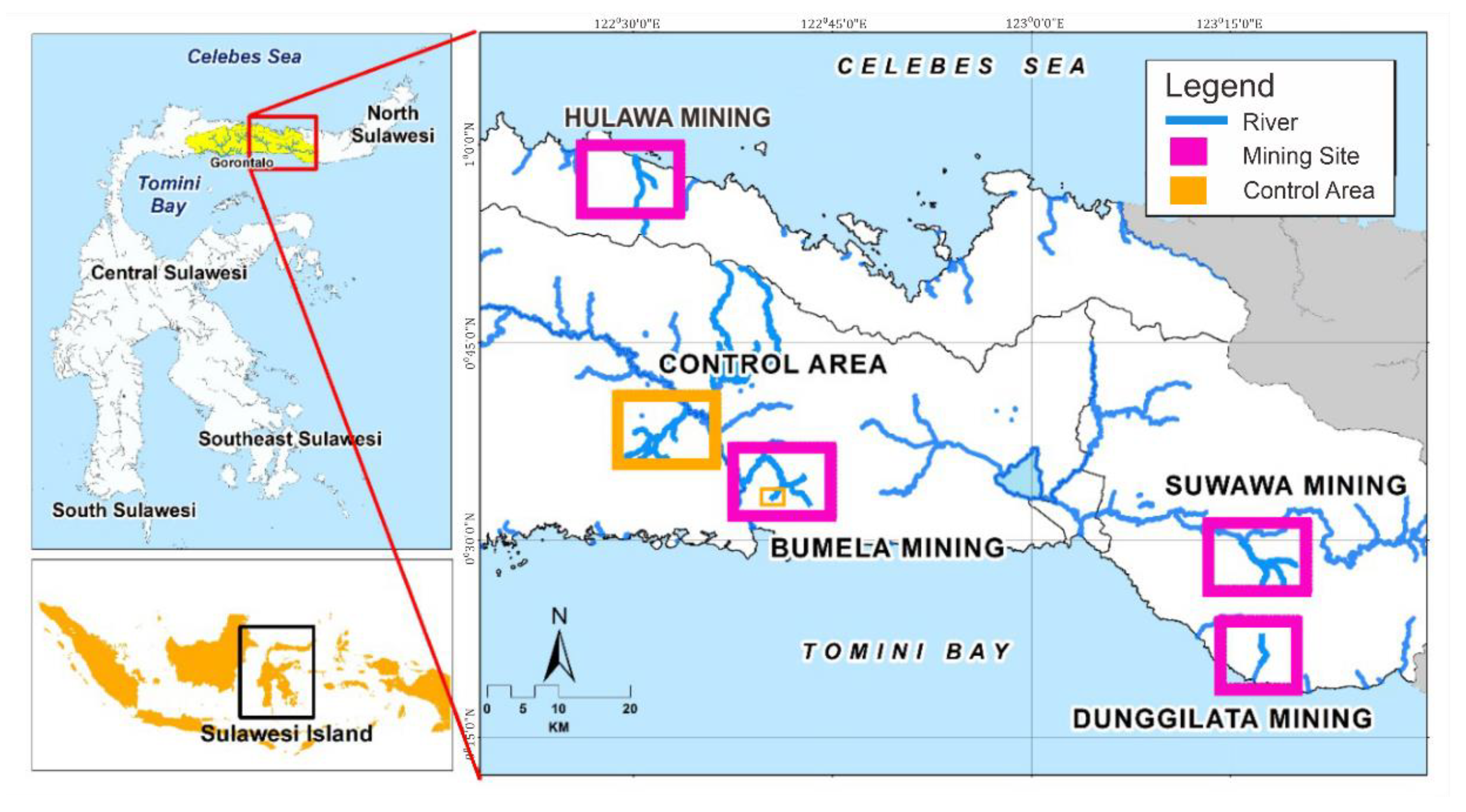
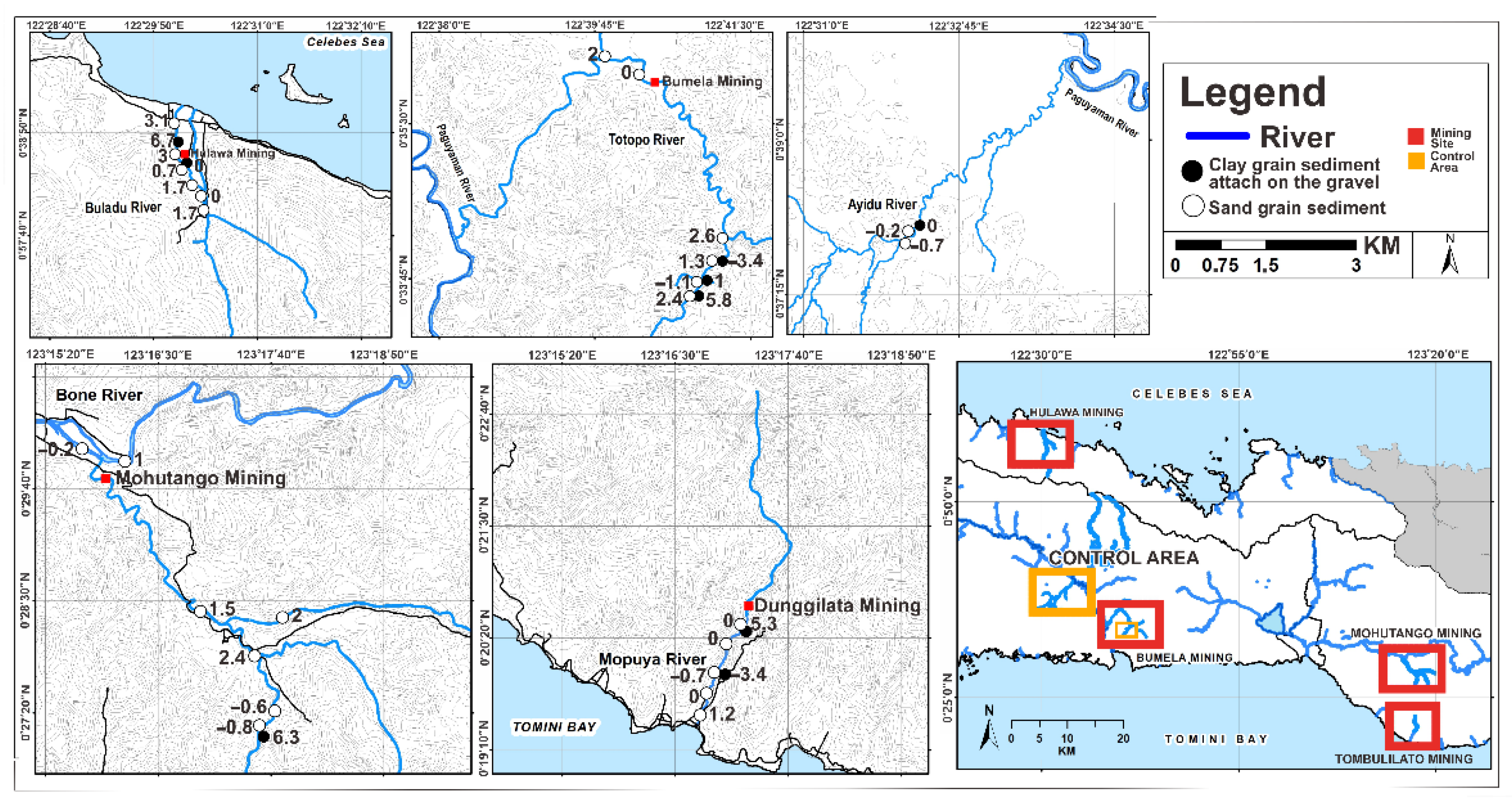
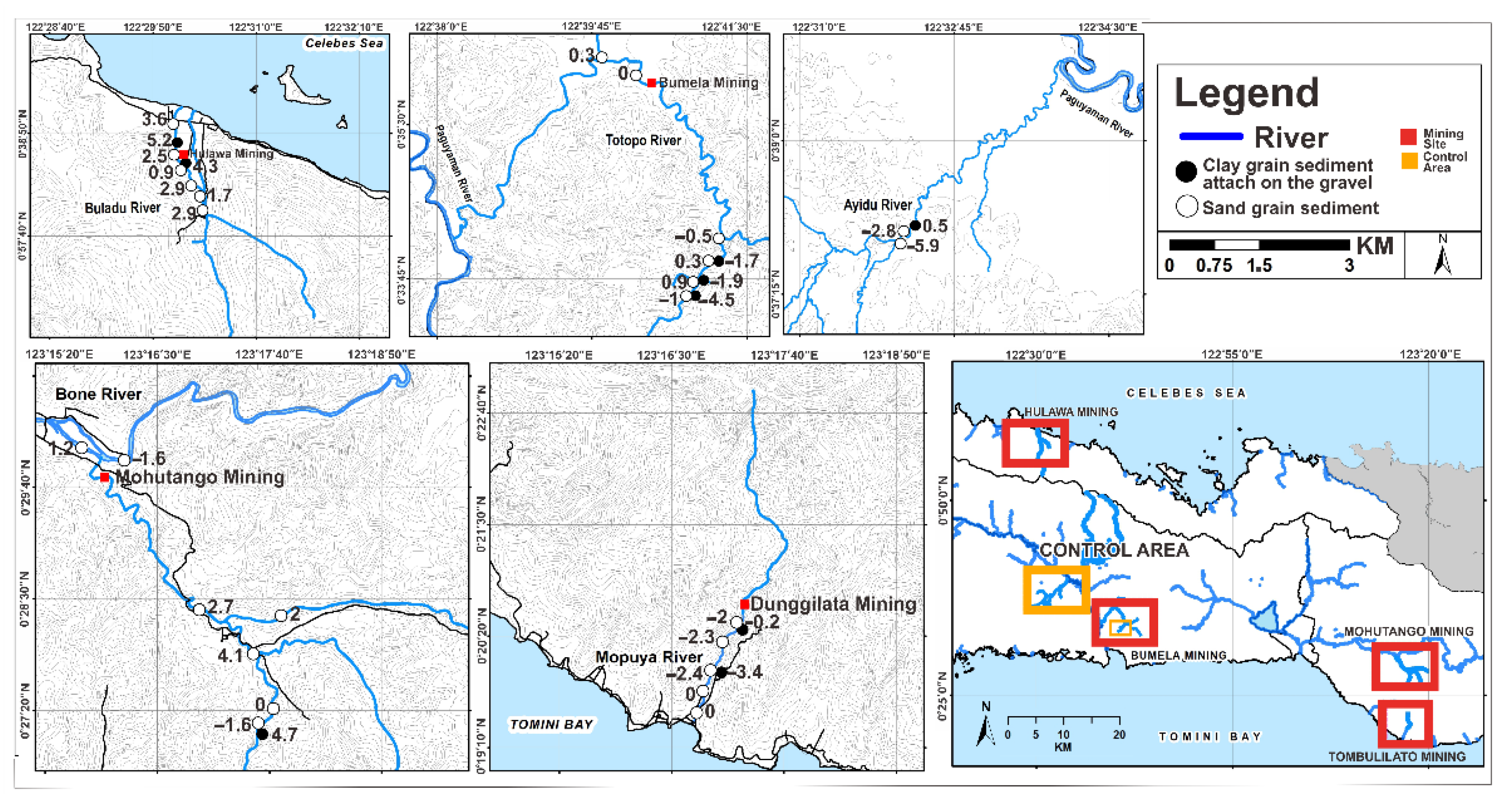
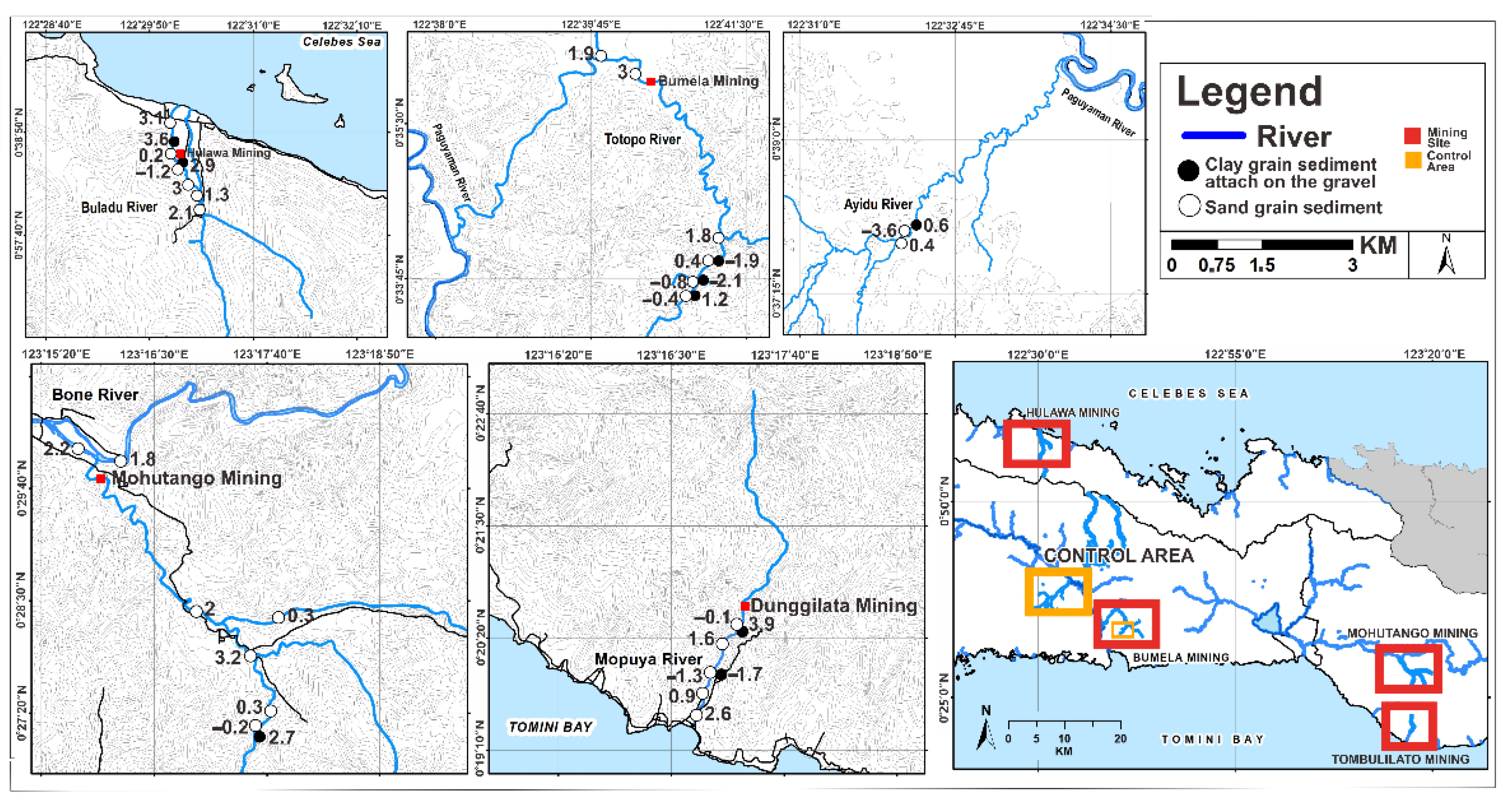
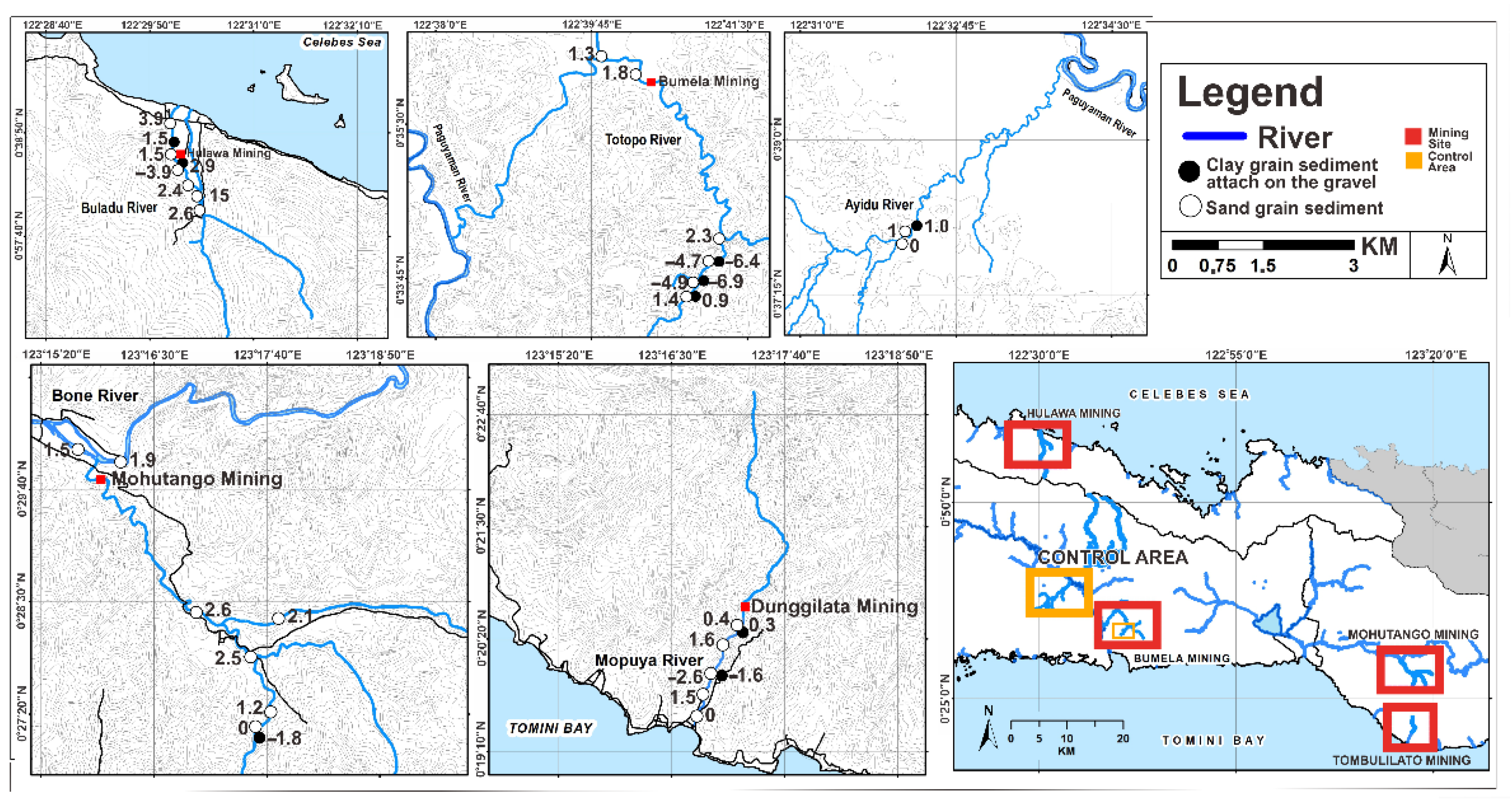
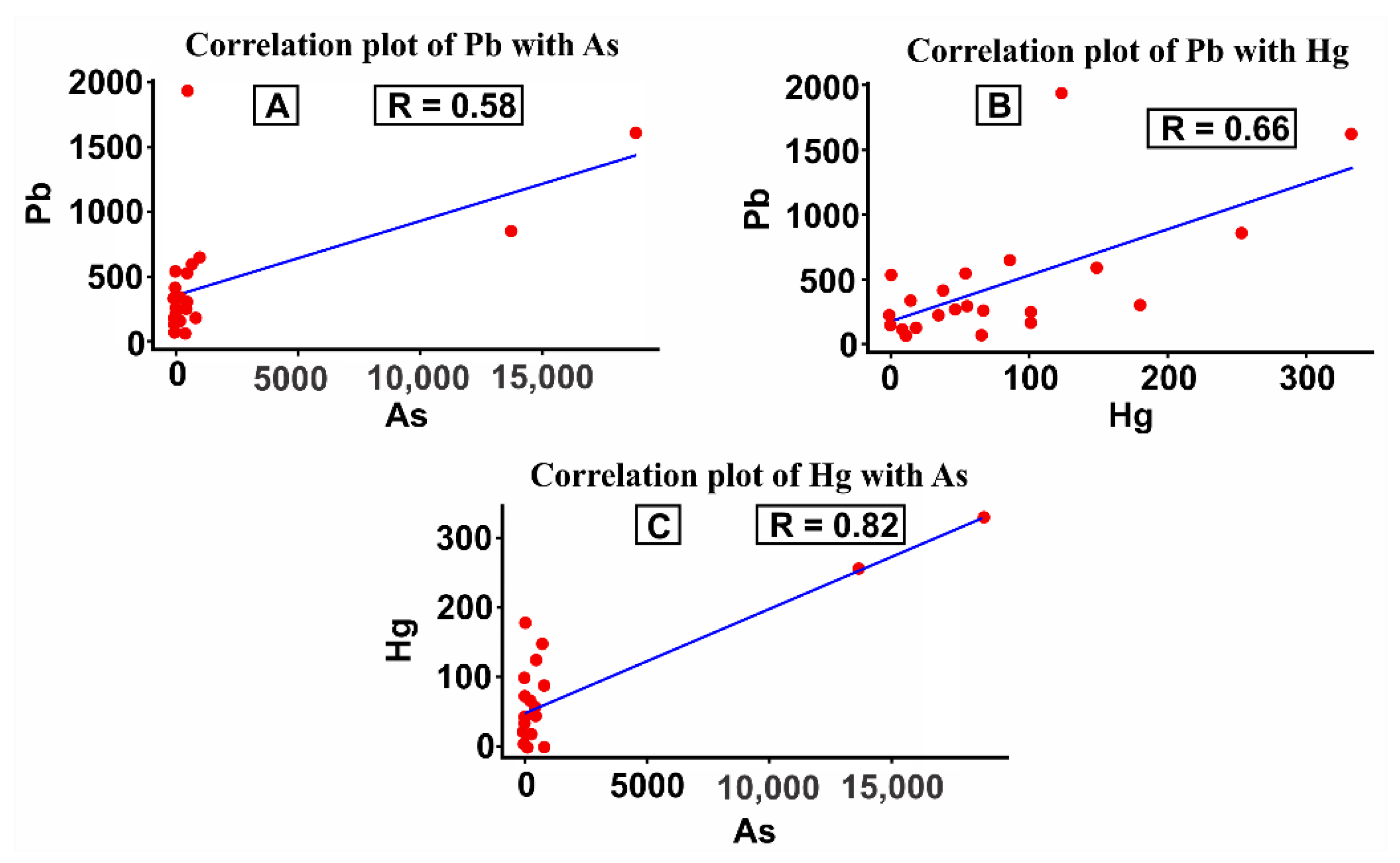
| Location | Element | Median | Min–Max |
|---|---|---|---|
| Buladu River (Sumalata Mining) | Sand | 54.7 | 0–147 |
| Clay | 0 | 0–334 | |
| Dunggilata River (Dunggilata Mining) | Sand | 10.1 | 0–38.1 |
| Clay | 0 | 0–124 | |
| Totopo River (Bumela Mining) | Sand | 53.6 | 0–101 |
| Clay | 0.15 | 0–179 | |
| Bone River (Suwawa Mining) | Sand | 33.7 | 86.3–9.5 |
| Clay | 0 | 0–256 | |
| Ayidu River (Control area) | Sand | 14.9 | 10.5–101 |
| Clay | 0 | 0–0 |
| Location | Element | Median | Min–Max |
|---|---|---|---|
| Buladu River (Sumalata Mining) | Sand | 230.5 | 30.2–589 |
| Clay | 1286.5 | 0–1610 | |
| Dunggilata River (Dunggilata Mining) | Sand | 124 | 27–412 |
| Clay | 985.2 | 0–1930 | |
| Totopo River (Bumela Mining) | Sand | 168.9 | 38.1–536 |
| Clay | 36.3 | 0–308 | |
| Bone River (Suwawa Mining) | Sand | 237 | 58.2–645 |
| Clay | 856 | 0–856 | |
| Ayidu River (Control area) | Sand | 93.6 | 5.5–187 |
| Clay | 198 | 0–198 |
| Location | Element | Median | Min–Max |
|---|---|---|---|
| Buladu River (Sumalata Mining) | Sand | 315.1 | 0–587 |
| Clay | 0 | 0–18,900 | |
| Dunggilata River (Dunggilata Mining) | Sand | 9.2 | 0–11.9 |
| Clay | 0 | 0–449 | |
| Totopo River (Bumela Mining) | Sand | 46.3 | 0–88.5 |
| Clay | 11.3 | 0–162 | |
| Bone River (Suwawa Mining) | Sand | 108 | 15.9–798 |
| Clay | 0 | 0–13,800 | |
| Ayidu River (Control area) | Sand | 0.8 | 0–6.7 |
| Clay | 0 | 0–729 |
| Location | Element | Median | Min–Max |
|---|---|---|---|
| Buladu River (Sumalata Mining) | Sand | 187.5 | 3.2–673.7 |
| Clay | 2562.1 | 0–4923 | |
| Dunggilata River (Dunggilata Mining) | Sand | 60.4 | 0–138.1 |
| Clay | 210.1 | 0–331 | |
| Totopo River (Bumela Mining) | Sand | 114.7 | 1.5–234.6 |
| Clay | 3.2 | 0–153.5 | |
| Bone River (Suwawa Mining) | Sand | 175.1 | 0–282.4 |
| Clay | 79.4 | 0–79.4 | |
| Ayidu River (Control area) | Sand | 90.8 | 0–102 |
| Clay | 549.2 | 0–549.2 |
| Classification of River Sediment Quality Standard | Element Concentration Limit | |||
|---|---|---|---|---|
| As | Pb | Hg | Zn | |
| Clay Grain Sediment Attach on Gravel | 342.3 | 88.5 | 2.1 | 184.9 |
| Sand Grain Sediment | 32 | 45.7 | 11.1 | 30.8 |
| Average Data in Control Area (Ayidu River and Totopo River) | ||||
Publisher’s Note: MDPI stays neutral with regard to jurisdictional claims in published maps and institutional affiliations. |
© 2022 by the authors. Licensee MDPI, Basel, Switzerland. This article is an open access article distributed under the terms and conditions of the Creative Commons Attribution (CC BY) license (https://creativecommons.org/licenses/by/4.0/).
Share and Cite
Basir; Kimijima, S.; Sakakibara, M.; Pateda, S.M.; Sera, K. Contamination Level in Geo-Accumulation Index of River Sediments at Artisanal and Small-Scale Gold Mining Area in Gorontalo Province, Indonesia. Int. J. Environ. Res. Public Health 2022, 19, 6094. https://doi.org/10.3390/ijerph19106094
Basir, Kimijima S, Sakakibara M, Pateda SM, Sera K. Contamination Level in Geo-Accumulation Index of River Sediments at Artisanal and Small-Scale Gold Mining Area in Gorontalo Province, Indonesia. International Journal of Environmental Research and Public Health. 2022; 19(10):6094. https://doi.org/10.3390/ijerph19106094
Chicago/Turabian StyleBasir, Satomi Kimijima, Masayuki Sakakibara, Sri Manovita Pateda, and Koichiro Sera. 2022. "Contamination Level in Geo-Accumulation Index of River Sediments at Artisanal and Small-Scale Gold Mining Area in Gorontalo Province, Indonesia" International Journal of Environmental Research and Public Health 19, no. 10: 6094. https://doi.org/10.3390/ijerph19106094
APA StyleBasir, Kimijima, S., Sakakibara, M., Pateda, S. M., & Sera, K. (2022). Contamination Level in Geo-Accumulation Index of River Sediments at Artisanal and Small-Scale Gold Mining Area in Gorontalo Province, Indonesia. International Journal of Environmental Research and Public Health, 19(10), 6094. https://doi.org/10.3390/ijerph19106094







